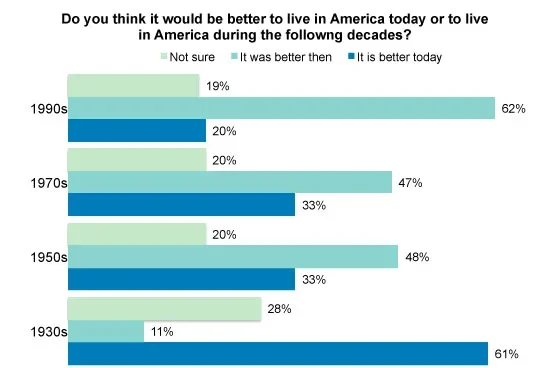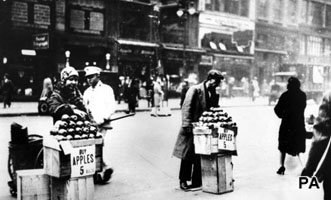Think about it. When you’re asked to consider whether today, or some undefined period yesteryear, is a preferable time in which to live, what would you say? Most people tend to respond with the undefined period yesteryear. Irrespective of whether it was, the past tends to feel easier; less stressful; simpler. Rose-tinted glasses, false memories and the daily stresses and strains of modern living tends to make people look at the past with fondness and nostalgia.
Quantitatively, it’s often not even the case: life has become easier for Americans. It’s generally less laborious (we now have dishwashers and washing machines), people are generally more affluent (owning cars and TVs was something previously the luxury of the very wealthy) and we tend to have more friends and freedoms than our parents or grandparents
Yet this perception, of the ease of yesterday, certainly runs true in America…to a point. We asked respondents to decide, out of each of the ‘odd decades’ (i.e. the 1930s, 50s, 70s or 90s), whether they think it was better to live in America now, or then. Overwhelmingly, respondents said ‘then’, except (tellingly) in relation to one decade: the 1930s.
Of our list of decades, most people (61%) felt the 1990s was their most preferred decade in which to live, with young people (18-29 years olds) and Republican identifiers feeling the most strongly (65% and 68% respectively). Starting with a recession in 1990, the country then experienced its longest period of economic expansion. Compared with today, it seems idyllic; a today that brings us a global recession and unemployment.
Where the 70s were concerned, more people still looked back to that era favorably, than favored today, though the certainty was missing: 47% of Americans favored the 70s, and 33% favored today. This option was popular among older Americans (those aged 65 and above), with 58% favoring the 1970s, but not as popular to them as the 1950s, which was seen overwhelmingly as the favored decade among this group. 68% of our older respondents figured the 1950s was a better time in which to live than today. The national average, while still generally in favor of the 50s, was just 48%. Perhaps the 1950s were a time of excitement: World Wars had ended, life was being rebuilt and crockery was becoming more colorful. Those who are more likely to remember the decade – or at least to have been born in it and therefore remember hearing about it firsthand – clearly have fond memories.
What was interesting about our survey, however, was that the only decade NOT preferred to today among Americans was the 1930s. The 1930s holds particular significance in today’s environment – the Wall Street Crash of 1929 marked the beginning of the worst recession America had ever seen, and one which affected industrialized countries all over the Western world. Sound familiar? Fully 61% of Americans consider today to be a better time in which to live, and this resonated among all age groups and all party affiliations. It suggests the comparison encourages Americans to put things into perspective: yes, things are tough here today, but when asked to consider living in the 30s, Americans would rather stay put.










